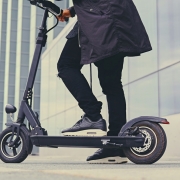Scooters Are the Newest Addition to the Sharing Economy
Overnight, the streets of Atlanta were filled with silent, electric scooters whizzing down the street. My first thought to myself after I had almost been run over by one of these “Bird” scooters for the first time, was to shake my fist and curse the “youths” for abusing their summer freedom. But to my surprise, the people operating these scooters were not juveniles. Instead, they were young professionals my own age in slacks and blazers, heading to or from work.
As a fan of the sharing economy, new transportation ideas always intrigue me. But this was one innovation I was reluctant to get behind. Not only were these scooters always almost colliding with pedestrians like myself, they also seemed ridiculous. There was nothing more out of place than a grown man on an electric scooter. But as much as I wanted to condemn these scooters, there was something about their almost immediate widespread adoption that had me standing in awe of the business model.
Scooter-Sharing Economy
For anyone unfamiliar with these electric scooters, they are quickly making their way across the country. Bird and its competitors offer ridesharing services with scooters that can be rented all around major U.S. cities. Using the same sharing economy model that brought us the likes of Uber and Airbnb, Bike sharing has already been adopted by many metropolitan cities over the last few years and these scooters fulfill a similar market demand.
But Bird scooters are different than Uber and Lyft, as they cater to commuters who only need to travel short distances, sometimes under a mile. For many commuters who take a bus or train to work, once they get to the final stop, there is still a bit of distance between them and their place of work. Rather than having to spend $5-$10 on an Uber or cab ride for short distances, participants in this new “scooter share” economy can hop on an electric scooter and get to work for under $2.
All a rider needs to do is download the app and use the GPS feature to locate a nearby scooter. Bird charges a flat rate of $1 per trip and allows the rider to leave the scooter at their final destination, where it will, hopefully, be rented to another user.
Each different scooter startup owns its fleet of scooters, making its model more similar to Zipcar than to Uber or Lyft. And while this model does put more financial burdens on the companies directly, since they to pay for the scooters as well as the maintenance associated with each, the company is still worth over $1 billion.
Banning Scooter-Shares
I was still on the fence about this new trend, since I still had to avoid getting hit by one each time I walked to work. But as someone who is morally outraged by regulation, my opinions of these little scooters began to change after a recent headline caught my attention. “Beverly Hills Bans Dockless Scooters,” they read. These scooters may be a bit annoying, but banning them seemed a bit extreme. The ban was implemented using the city’s “urgency ordinance” and will last for a period of six months, in which the city council will deliberate on how they can attempt to regulate it. It appears that the spontaneous adoption of scooter shares have left regulators with little time to figure out how they can regulate it.
Beverly Hills is not the first city to ban these scooters. The city is following in the footsteps of West Hollywood and Santa Monica. If there is one thing red tape creators loath it is permissionless innovation. But these Bird scooters seem too popular with consumers to cower under the first signs of struggle. After all, Uber and Lyft have both had to endure similar attempts at regulation, but they have managed to survive because consumers vote with their dollars.




